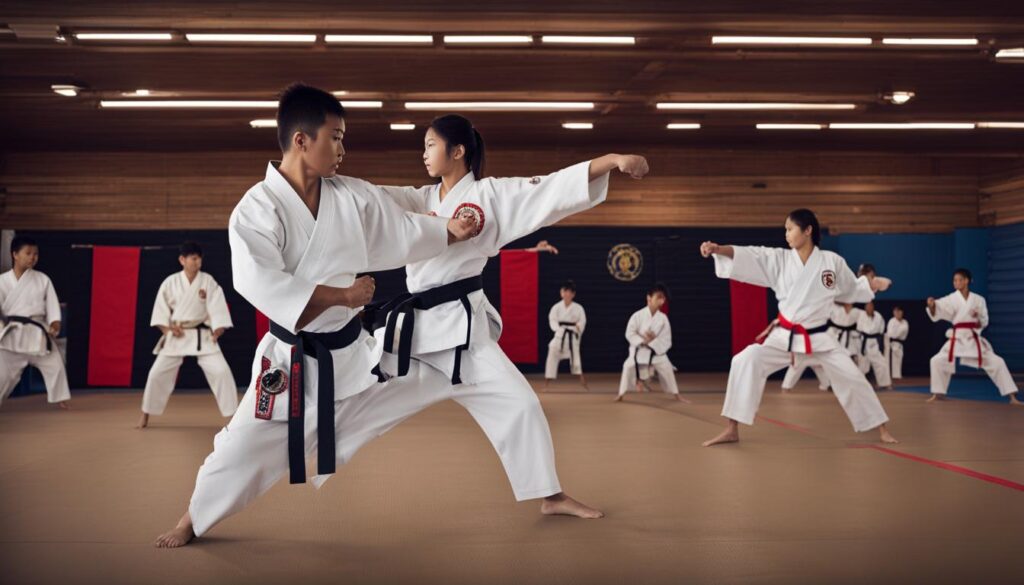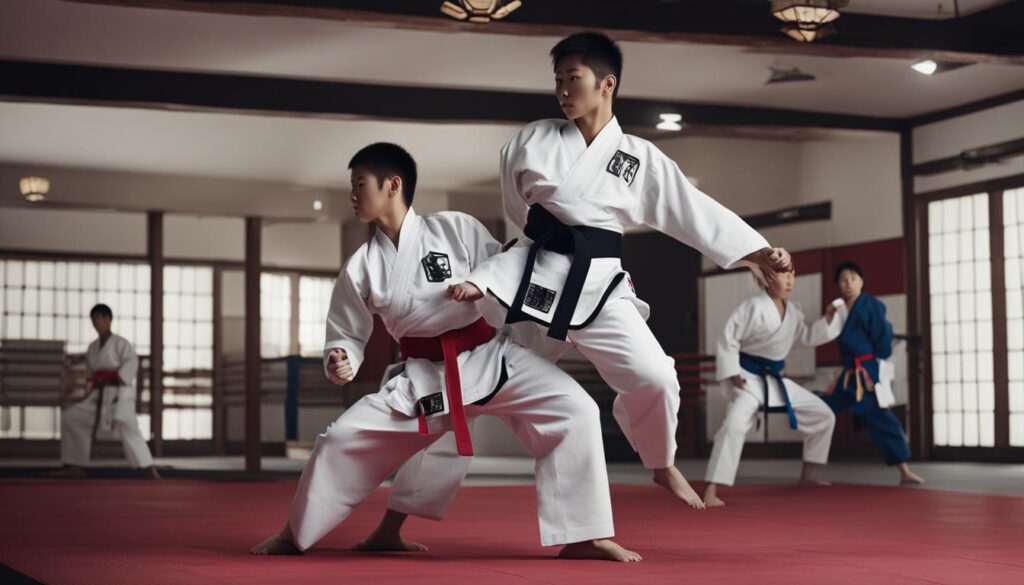Taekwondo and Karate are two popular forms of martial arts that have captivated people around the world. While they may seem similar at first glance, there are key differences that set them apart. Understanding these differences is essential for anyone interested in practicing martial arts. In this article, we will explore the contrast between Taekwondo and Karate, examining their origins, techniques, styles, and benefits to help you make an informed decision.
Key Takeaways:
- Taekwondo and Karate are two distinct martial arts forms with different techniques and origins.
- Taekwondo focuses more on kicking techniques, while Karate emphasizes hand strikes.
- Taekwondo originated in Korea, while Karate originated in Japan.
- Both Taekwondo and Karate offer physical and mental benefits, including self-defense skills and improved fitness.
- Choosing between Taekwondo and Karate depends on personal preferences and goals.
Techniques in Karate and Taekwondo
In both Karate and Taekwondo, beginners learn fundamental rules and basic moves. Both forms involve different stances, punches, kicks, and blocking techniques. However, Karate puts more emphasis on hand techniques and uses kicks as backup, while Taekwondo focuses more on kicking techniques and uses hands as backup. Both forms require practice, precision, and coordination to execute the techniques effectively.
Beginners in Karate and Taekwondo start with learning the foundational moves and techniques that form the building blocks of these martial arts. These moves include various stances, punches, kicks, and blocks, each with its own unique purpose and execution.
Karate: Karate practitioners concentrate on perfecting their hand strikes, such as punches, open-hand strikes, and knife-hand strikes. These techniques aim for efficient and powerful hand-to-hand combat. While hand techniques are the primary focus in Karate, practitioners also incorporate a variety of kicks to diversify their combat approach.
Taekwondo: Taekwondo places a heavier emphasis on kicking techniques. Practitioners learn different types of kicks, including front kicks, roundhouse kicks, side kicks, and spinning kicks. These dynamic kicking techniques are designed to deliver high-impact strikes with speed and precision, allowing practitioners to maintain distance and create openings for further attacks.
Similarities: Although Karate and Taekwondo differ in their emphasis on hand and kicking techniques, there are similarities between the two. Both forms emphasize the importance of proper stances, body alignment, and balance. Practitioners in both martial arts are trained to deliver techniques with speed, power, and accuracy.
Note: The effectiveness of these techniques depends on the individual practitioner’s skill level, physical attributes, and training. Regular practice, dedication, and guidance from experienced instructors are essential to mastering the techniques in both Karate and Taekwondo.
Stay tuned for the following sections where we will explore the origins of Karate and Taekwondo, the different styles within each discipline, and the physical and mental benefits these martial arts offer.
Origins of Karate and Taekwondo
Karate and Taekwondo are two martial arts with fascinating origins, each rooted in different cultures and time periods. Understanding their origins provides valuable insights into their development and evolution over the years.
Karate originated in Okinawa, Japan around 500 years ago. It was born out of necessity as a form of self-defense after the Japanese government banned the use of weapons on the island. In response, the people of Okinawa developed a system of unarmed combat known as Karate. The techniques and principles of Karate were influenced by Chinese martial arts and eventually evolved into a distinct style.
Taekwondo, on the other hand, has ancient roots that date back to 50 B.C.E. in Korea. The origins of Taekwondo can be traced to the Three Kingdoms period, where it was practiced as a form of martial arts by the warriors of the Silla Dynasty. Throughout history, Taekwondo was influenced by various Chinese and Japanese martial arts, leading to the development of different styles within the discipline.
During the Japanese occupation of Korea in the early 20th century, the practice of Taekwondo was banned, and it was driven underground. However, after Korea gained independence, Taekwondo underwent a resurgence and gradually spread worldwide.
Both Karate and Taekwondo have undergone significant transformations over time, adapting to new influences and evolving into the forms we know today. These martial arts have become symbols of cultural heritage and continue to captivate practitioners and enthusiasts around the world.
Karate Styles
Karate is a martial art that has evolved over time, giving rise to various styles. These styles each have their own unique characteristics, techniques, philosophy, and training methods. Understanding the different karate styles can help practitioners choose the one that aligns with their interests and goals.
Some of the most common and distinct karate styles include:
- Gōju-ryū
- Shitō-ryū
- Shotokan
- Wadō-ryū
Each style has its own approach to techniques and forms, emphasizing different aspects of karate. For example, Gōju-ryū places a strong emphasis on close-quarter combat and body conditioning, while Shotokan focuses on strong, powerful strikes. Shitō-ryū incorporates a combination of hard and soft techniques, while Wadō-ryū emphasizes fluid movements and evasion. These styles offer practitioners a diverse range of training experiences and philosophies to explore.
The World Karate Federation (WKF) serves as the governing body for karate at a professional level. It provides guidelines and standards for practicing and competing in karate. The WKF ensures that competitions are fair, safe, and adhere to the principles of the different karate styles.
Whether you’re interested in the precise strikes of Shotokan or the dynamic movements of Gōju-ryū, exploring the different karate styles can deepen your understanding of this martial art and help you find a style that resonates with you.
Taekwondo Styles
Taekwondo, like Karate, has various styles that have evolved over time. These styles offer unique techniques, forms, and training methods, catering to the diverse preferences and goals of practitioners. Each style may have its own distinct characteristics, emphasizing specific aspects of the martial art. Let’s explore some of the prominent Taekwondo styles:
Hongyang
Hongyang is a traditional Taekwondo style known for its focus on powerful and dynamic techniques. It emphasizes strong kicks, explosive movements, and effective self-defense strategies. This style promotes physical fitness, mental discipline, and the development of self-confidence.
Kukkiwon
Kukkiwon is the official Taekwondo style recognized by the World Taekwondo Federation. It is highly structured, emphasizing precise techniques, controlled movements, and standardized forms (known as poomsae). Kukkiwon style is widely practiced around the world and is the foundation for Taekwondo competitions.
ITF-style
The International Taekwon-Do Federation (ITF) style is rooted in the traditional aspect of Taekwondo. ITF-style practitioners focus on fundamental techniques, patterns, and self-defense applications. This style places emphasis on discipline, respect, and the development of mental fortitude.
| Comparison of Taekwondo Styles | |
|---|---|
| Style | Characteristics |
| Hongyang | Powerful and dynamic techniques, strong kicks, effective self-defense |
| Kukkiwon | Precise techniques, controlled movements, standardized forms (poomsae) |
| ITF-style | Focus on fundamentals, patterns, and self-defense applications |
The World Taekwondo Federation, as the governing body for Taekwondo, sets the standards for competition rules and new developments in the sport. It ensures consistency and fairness across different styles and provides a platform for practitioners to showcase their skills at an international level.

Practiced by individuals around the world, Taekwondo offers a rich diversity of styles that cater to various preferences and objectives. Whether you’re drawn to the explosive power of Hongyang, the precision of Kukkiwon, or the traditional values of ITF-style, there is a Taekwondo style suited for you.
Physical Benefits of Karate and Taekwondo
Both Karate and Taekwondo offer numerous physical benefits. Practicing these martial arts provides a full-body workout that helps build strength, improve flexibility, and enhance cardiovascular fitness. Whether it’s the rapid kicks of Taekwondo or the powerful strikes of Karate, these techniques engage multiple muscle groups and promote overall physical fitness.
One of the key advantages of training in Karate and Taekwondo is the development of self-defense skills. Students learn techniques and strategies to protect themselves in real-life situations. By practicing various strikes, kicks, and blocks, individuals can improve their ability to defend themselves effectively.
While the specific physical benefits may vary depending on the individual’s training intensity and dedication, the overall impact is transformative. Regular practice of Karate and Taekwondo can lead to increased strength, agility, balance, and coordination. These martial arts require discipline and focus, which contribute to mental well-being as well.
Overall, Karate and Taekwondo are not just about learning how to throw punches or perform high kicks. They are holistic martial arts that provide a comprehensive physical workout while also building self-defense skills.
Mental Benefits of Karate and Taekwondo
Practicing Karate or Taekwondo not only provides physical fitness and self-defense skills but also offers significant mental benefits. Both martial arts promote discipline, focus, perseverance, and self-confidence, contributing to overall mental well-being. Mental strength and concentration are crucial in executing techniques effectively and overcoming challenges.
Through the rigorous training involved, practitioners develop mental resilience and learn to push their limits. Both Karate and Taekwondo require practitioners to stay present in the moment, enhancing mindfulness and concentration. These martial arts also foster problem-solving skills, as students learn to analyze situations and respond appropriately.
“Martial arts training provides opportunities for personal growth, empowering individuals to overcome obstacles and achieve their goals,” says Sensei Jennifer Martinez, a 5th-degree black belt in Karate.
Furthermore, practicing Karate or Taekwondo can boost self-confidence and improve self-esteem. As students progress and master new techniques, they gain a sense of achievement and pride. The challenges they encounter during training teach them resilience and the value of hard work.
By emphasizing discipline and focus, both Karate and Taekwondo cultivate mental attributes that extend beyond the training mat. Students often find that their increased mental strength positively impacts other areas of their lives, such as academics, work, and personal relationships. These martial arts become a tool for personal growth and self-improvement.
To sum up, Karate and Taekwondo not only shape practitioners physically but also nurture their mental well-being. The mental benefits gained from these martial arts contribute to greater discipline, focus, perseverance, self-confidence, and problem-solving abilities.

| Karate | Taekwondo |
|---|---|
| Discipline | Discipline |
| Focus | Focus |
| Perseverance | Perseverance |
| Self-confidence | Self-confidence |
| Problem-solving skills | Problem-solving skills |
Competitions in Karate and Taekwondo
Both Karate and Taekwondo have their own unique set of rules and guidelines when it comes to competitions. These competitions serve as platforms for practitioners to showcase their skills and compete against others in a structured environment.
Karate Competitions:
In Karate competitions, equal points are typically awarded for both punches and kicks. Judges evaluate the execution of techniques based on criteria such as form, accuracy, and timing. Competitors strive to demonstrate precision and effective strikes while showcasing their understanding of Karate principles.
Taekwondo Competitions:
Taekwondo competitions, on the other hand, give higher points to kicks. This aligns with the core focus of Taekwondo, which emphasizes dynamic and powerful kicking techniques. Competitors aim to execute kicks with agility, speed, and accuracy while incorporating swift footwork and strong defensive maneuvers.
Both Karate and Taekwondo competitions provide participants with a valuable opportunity to test their skills, gain experience, and challenge themselves against fellow practitioners. These events foster a spirit of healthy competition and help athletes grow in their martial arts journey.
| Karate Competitions | Taekwondo Competitions | |
|---|---|---|
| Points | Equal points for punches and kicks | Higher points for kicks |
| Technique Evaluation | Form, accuracy, and timing | Agility, speed, accuracy, footwork, and defensive maneuvers |
Choosing Between Karate and Taekwondo
The choice between Karate and Taekwondo ultimately comes down to individual preferences and goals. Both martial arts have their own unique styles and characteristics, and what may be better for one person may not necessarily be the same for another.
In Taekwondo, there is a strong emphasis on kicking techniques. If you enjoy high-flying kicks and explosive moves, Taekwondo may be more suitable for you. It is known for its dynamic and acrobatic kicks, making it a popular choice for those who want to focus on leg techniques.
Karate, on the other hand, offers a balance of hand and leg techniques. It places equal importance on punches and kicks, making it a well-rounded martial art. If you prefer a mix of both hand strikes and kicks, Karate may be the martial art for you.
When choosing between Karate and Taekwondo, it’s also important to consider factors such as the quality of instruction, the atmosphere of the training facility, and the location. Finding a reputable and experienced instructor can greatly impact your learning experience and progress in either martial art.
If you’re still undecided, one way to make an informed decision is to try beginner classes in both Karate and Taekwondo. By experiencing the training firsthand, you can better assess which martial art aligns with your interests, goals, and overall enjoyment.
Remember, the most important thing is to choose a martial art that you enjoy and are motivated to practice consistently. Whether you choose Karate or Taekwondo, both provide opportunities for physical fitness, self-defense skills, personal growth, and a sense of accomplishment.

Transformation Through Karate and Taekwondo
Both Karate and Taekwondo have the power to transform the body and mind. These martial arts offer a wide range of benefits, including physical fitness, self-defense skills, discipline, and character development.
When it comes to physical fitness, both Karate and Taekwondo provide a complete workout that engages the entire body. The rigorous training routines help build strength, improve flexibility, and enhance cardiovascular fitness. By practicing these martial arts, individuals can improve their overall physical well-being and achieve a higher level of fitness.
Self-defense skills are another significant benefit of both Karate and Taekwondo. The techniques learned in these disciplines can be useful in real-life situations, providing individuals with the confidence and ability to protect themselves and others. The training focuses on developing effective striking techniques, blocking maneuvers, and strategic positioning.
Discipline is ingrained in the practice of Karate and Taekwondo. Practitioners learn to follow strict training protocols, adhere to ethical principles, and respect their instructors and fellow students. The emphasis on discipline helps individuals develop self-control, patience, and a strong work ethic.
Character development is an important aspect of Karate and Taekwondo. These martial arts teach virtues such as honesty, perseverance, humility, and respect. Through dedicated practice and continuous improvement, practitioners develop a strong sense of personal integrity and foster positive character traits that extend beyond the training mat.

Through the dedication, perseverance, and continuous improvement required in Karate and Taekwondo training, individuals have the opportunity to undergo a transformative journey. These martial arts provide a path to personal growth, self-confidence, and a sense of accomplishment. Whether one chooses Karate or Taekwondo, the journey is one that can shape them both mentally and physically.
Martial Arts as a Lifestyle
Karate and Taekwondo offer more than just physical training; they can become a lifelong journey and a way of life for many practitioners. The dedication and commitment required in training extend beyond the martial arts themselves, shaping the way practitioners approach various aspects of their lives.
Practitioners often find that the principles and values learned in Karate or Taekwondo permeate other areas, such as relationships, work, and personal growth. The discipline, focus, perseverance, and self-confidence cultivated through practicing these martial arts can have a profound impact.
The principles learned on the mat, such as respect, integrity, and humility, can be applied to daily life, leading to enhanced interactions with others and a more balanced approach to challenges. The mental strength developed through training can help practitioners overcome obstacles and achieve their goals in various spheres of life.
Many practitioners also find that the physical fitness gained from Karate or Taekwondo spills over into improved overall well-being. Regular exercise and the mental discipline required in training contribute to increased energy levels, reduced stress, and improved mental clarity.
Whether it’s the physical, mental, or emotional benefits, the practice of Karate or Taekwondo can provide practitioners with a sense of purpose and fulfillment throughout their lives.
Testimonial:
I started practicing Taekwondo as a way to stay fit, but it quickly became much more than that. The discipline and values I learned on the mat have influenced how I approach challenges in my personal and professional life. Taekwondo has brought balance, focus, and a sense of purpose to my everyday activities. It truly is a lifestyle.
Conclusion
In conclusion, both Karate and Taekwondo are highly respected martial arts with their own unique aspects and advantages. The choice between the two ultimately depends on individual preferences, personal goals, and the quality of instruction available.
Both Karate and Taekwondo offer physical fitness benefits, helping practitioners to improve strength, flexibility, and cardiovascular endurance. Moreover, they provide valuable self-defense skills and promote mental discipline, including focus, perseverance, and self-confidence.
To make an informed decision, it is advisable to try beginner classes in both Karate and Taekwondo. This allows individuals to experience and understand the techniques, training methods, and overall atmosphere of each martial art. By exploring these options, individuals can find the martial art that best aligns with their specific interests and objectives.
FAQ
What is the difference between Taekwondo and Karate?
Taekwondo and Karate are both martial arts forms, but they have distinct differences. Taekwondo emphasizes kicking techniques, while Karate focuses more on hand strikes.
What are the techniques in Karate and Taekwondo?
Both Karate and Taekwondo involve different stances, punches, kicks, and blocking techniques. However, Karate puts more emphasis on hand techniques, while Taekwondo focuses more on kicking techniques.
What are the origins of Karate and Taekwondo?
Karate originated in Japan around 500 years ago, while Taekwondo dates back to 50 B.C.E. in Korea. Karate was developed as a form of self-defense in Okinawa after weapons were banned, and Taekwondo was influenced by Chinese and Japanese martial arts, practiced in secret during the Japanese occupation.
What are the different styles of Karate?
Karate has different styles, including gōju-ryū, shitō-ryū, shotokan, and wadō-ryū. Each style may have variations in techniques, philosophy, and training methods.
What are the different styles of Taekwondo?
Taekwondo also has different styles that may vary in terms of techniques, forms, and training methods.
What are the physical benefits of Karate and Taekwondo?
Both Karate and Taekwondo provide a full-body workout, helping to build strength, improve flexibility, and enhance cardiovascular fitness.
What are the mental benefits of Karate and Taekwondo?
Practicing Karate or Taekwondo promotes discipline, focus, perseverance, self-confidence, problem-solving skills, and overall mental well-being.
What are the rules in Karate and Taekwondo competitions?
Karate competitions generally give equal points for punches and kicks, while Taekwondo competitions give higher points to kicks. Judges evaluate the execution of techniques based on criteria such as form, accuracy, and timing.
How do I choose between Karate and Taekwondo?
The choice between Karate and Taekwondo depends on individual preferences and goals. Trying beginner classes in both disciplines can help in making an informed decision.
What are the benefits of practicing Karate or Taekwondo?
Karate and Taekwondo offer physical fitness, self-defense skills, discipline, character development, personal growth, self-confidence, and a sense of accomplishment.
How can Karate or Taekwondo become a way of life?
The dedication and commitment required in training can extend beyond the martial art itself, permeating other aspects of practitioners’ lives and providing a sense of purpose and fulfillment.
